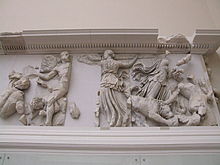Asteria (Titaness)
Asteria (Ancient Greek Ἀστερία) is a Titanide of Greek mythology.
In Hesiod's Theogony and subsequently in later mythographers she is the daughter of the Titan Koios and the Titanide Phoibe as well as the sister of Leto. In Perses she is the mother of Hecate, although here the fathers Zeus and Polus have also been handed down as variants. According to Eudoxos of Knidos and Cicero she is also the mother of the Tyrian Heracles, Nonnos of Panopolis names her as the daughter of Hyperion and as the wife of the river god Hydaspes.
The myth of a floating island supported by columns rising from the seabed on the occasion of the birth of Apollo and Artemis by Leto is already known to Pindar. Whether the family relationship of Leto and Asteria is known to Pindar is unclear. In Kallimachos and following him in the Library of Apollodorus, Asteria, fleeing from Zeus, plunges into the sea to float about as a floating island until she offers herself to Leto as a birthplace. Hyginus Mythographus, as the best-known version of the myth, reports that Asteria is transformed by Zeus into a quail (ortyx), which is plunged into the sea because it rejects his advances. From it is born the floating "quail island" Ortygia. On Hera's instructions, Asteria's sister Leto is not allowed to give birth where the sun shines. At the same time, she sends Python to pursue Leto. Zeus therefore has Leto brought to Poseidon by the wind god Boreas, who takes her to Ortygia. Ortygia sinks into the sea to give birth to the twins and has been called Delos ("the visible one") since her reappearance.
In Apollodor's library she transforms herself into a quail in order to flee from Zeus. In Servius she asks the gods to metamorphose her into a quail, but when diving through the sea she is transformed by Zeus into a rock, which then rises to the surface as an island at Leto's request. Apollo attaches her to the neighboring islands of Gyaros and Mykonos after his birth.
A pictorial representation of Asteria is found on the south frieze of the Pergamon Altar between Leto and Hecate.

Phoibe and Asteria, Pergamon Altar
Search within the encyclopedia